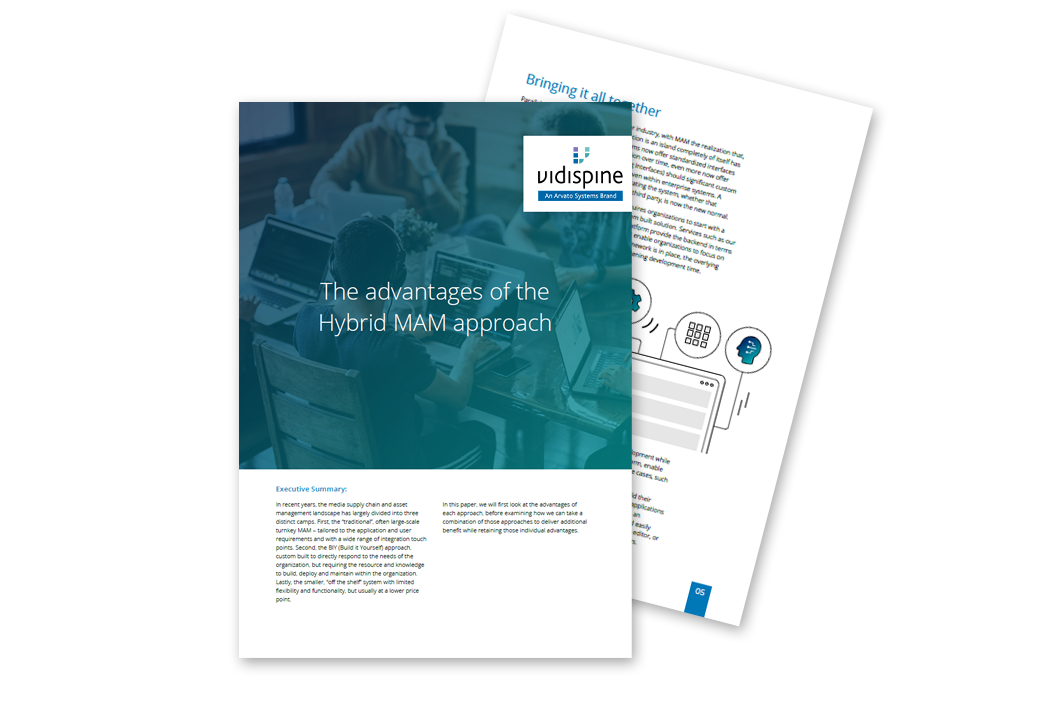
What is Media Asset Management?
Media Asset Management Solutions
Keeping track of and manage goods, components, parts have been an essential knowledge for all industries and business platforms at all times. Grocery stores, car manufacturers, builders all have the same related challenges to streamline their supply chains and market solutions. Keeping track of and manage media files in any form is no different, of course.
So, what is Media Asset Management?
In the digital world, assets can multiply rapidly; delivery to a number of viewers can vary from high peaks to limited demands. So, you need to store, find, process and deliver your media assets in the most efficient way to stay competitive on the market. To manage your media assets, you, therefore, need a software technology that not only gives you the necessary information about your assets but also can store and conform this information for you to make the required workflow decisions. Preferably automatically. This is media asset management, or as it may also be called: a MAM solution.
Makes sense? All clear?
Maybe not – so let’s take a look at some details and examples of some of the challenges in managing your digital media assets and how these challenges can be solved for your business model to make sense.
Managing digital media files in its simplest form may only allow for storing the actual data in folders and subfolders with the correct descriptive naming and a sidecar XML with metadata at its best. A lot of media asset management workflows start this way and sometimes never really changes. In such a solution, the user will need to navigate manually to the asset and import or export the asset to the next production point. With no clue what´s inside the asset more than what the filename or folder name reveals. For this simplistic way of managing media files, the general OSX finder or the Windows Explorer becomes your very basic MAM experience.
When storages and media supply chains expand, it becomes apparent that you also need a much more efficient and capable system to manage your media assets – yes, now you need a MAM solution. In these environments, the OSX finder and the Windows explorer cannot provide the search granularity or more advanced media management you need any more

In this whitepaper, we will give you insights into different MAM approaches, their advantages, and how to choose the best MAM system based on your requirements.
Media Asset Management Solutions for production
Let’s take a look at some examples where efficient cloud media asset management solutions can make an important difference to your daily production environment.
When production environments grow, the requirements of managing media changes, multiple users need to track and find not only media contents by name but also by more complex metadata gathered by advanced technical and cognitive methods.
Many customer's media supply chains also need to provide a cloud environment for offline editing, compliance, and remote editing work. This requires maintaining a relationship between cloud proxy media information and on-premise source media and information in as an example. We may also need to start tracking the relationship between media files and production project files, as well as associated media such as text, graphics and stills that make up those projects.
The MAM solutions available need to gather metadata information from many integrated services and production points to drive automatic ingest, transcode, and delivery workflows.
- When a journalist needs to quickly find all media assets between 2014 and 2016 covering a certain politician talking about a particular topic, the MAM system provides the interface and the technology to find media assets and time spans inside media assets with the information needed.
- When vast amounts of raw footage arrive at the production house, the MAM systems ingest services analyzes and logs the necessary metadata describing the clips by what’s actually also inside the media assets themselves. When the editor searches for two actors in a specific environment talking about a particular topic, this media is presentment to the editor with speed and accuracy.
From project creation and collecting media, to the export and storage of edited material, users benefit from a series of features designed to simplify the spectrum of tasks involved in a modern, collaborative and cloud-connected editing environment.
Media Asset Management Solutions for distribution
The technologies of a MAM system are also used further down the line of a media supply chain. The media needs to be prepared both at a metadata level as well as a media distribution format. The MAM system keeps track of the assets, rights management, the scheduling and delivers the media files to the correct destinations at the correct time. Quick and dynamic upscale and downscale of distribution resources is also an essential feature set to manage this distribution side of the media supply chain.
Media asset management solutions for distribution in a media supply chain again uses the same technologies but for different tasks and is here, therefore, more commonly referred to as a CMS (Content Management System).
Media Asset Management Tools and definitions
So, a MAM system manages media files as a general definition, but since there are many different parts of a media supply chain – from production all the way to final distribution we also see different definitions and names for the same management environment and media asset management tools.
In a production environment, a MAM system has some overlap with a PAM (Production Asset Management) system. Similarly, at the distribution side, there is a a lot of commonality with a CMS (Content Management System). In between, we also use terms like DAM (Digital Asset Management) to specify that not only media files are being managed but all types of digital files such as text, binaries, projects, and pictures – a MAM system may manage some these files too, and also contain data about non-digital assets, or assets that are not yet digitized.
We could – or should define our management solution based on what type of management and at what point in the media supply chain, our solution is being applied and used.
So don’t be confused if someone refers to a DAM when you are asking for MAM solution – but it is was really a PAM you were looking for or similar
What’s the Difference between VAM, DAM & MAM?
It’s easy to get lost in the many acronyms being thrown around within the industry. You are more than likely familiar with at least one or two but might just have heard about the others. Understanding the difference between these asset management systems and picking the right one can make or break your content creation efforts:
- DAM - Digital asset management
DAM is great for managing brand and image assets. It’s mainly focused on managing already finished digital assets. The key functionalities of DAM solutions include uploading, searching, and transforming digital assets for several different formats. At times, DAM is used as an umbrella term that other more specialized asset management solutions sit under. - MAM - Media asset management
MAM was traditionally focused on archiving and storage of video assets, but, being pioneered by the broadcast media, it was expanded to serve other functions, including the distribution of media. With the increase of businesses producing multimedia content, Media asset management tools have grown to accommodate a much wider array of needs. - VAM - Video asset management
VAM, or as it’s often referred to - VDAM (Video Digital Asset Management), is a subset of MAM. A MAM system includes additional advanced functions beyond the basic store and search functions to handle both pre- and post-production. For example, editing, collaboration, sharing, and version tracking. VAM usually integrates within a larger MAM or DAM system and enables direct uploading to distribution channels (such as YouTube or Vimeo).
Asset management is the foundation of a media supply chain, just as the media supply chain is the foundation of a business. Take control over your asset management with the Vidispine solutions and learn how we can maximize your media potential.
Digital Asset Management and Cloud Media Asset Management
In our new Content Ecosystem, you will find all the applications, services, and platforms necessary to develop your next-generation cloud media asset management solution for your business and platform.
It all starts with our media service platform VidiNet where you add and configure your necessary services and applications. In this environment, you will be able to run parallell test and stage environments to verify functionality and get cost estimations.
Yes, we know - quite flexible, right?
The VidiFlow solution is the orchestrator where you will able to configure and automate essential parts of your media supply chain described above by designing and executing BPMN standardized workflows using VidiFlow UI or API.
Our cloud-native VidiFlow workflow designer connects to the media management back-end service, VidCore and together with our own and 3rd party services and applications forms a complete and adaptable MAM system ready to manage any part of your media supply chain with the necessary assignments making VidiFlow a true cloud media asset management solution.
Basically, VidiFlow acts as a stable, secure, scalable, and high-density “operating system” connecting the dots of the VidiCore object repository, our cloud-native VidiNet media services platform and a growing number of 3rd party components.
Vidispine, of course, also acknowledges the reality and need for many customers to use on-premise storages and systems. Because of this, our MAM architecture and solutions integrate independently of environments making our Content ecosystem truly a hybrid media supply chain if needed.
We hope this article gave you some new ideas on how to improve your media supply chain.
Your Contacts for Media Asset Management





